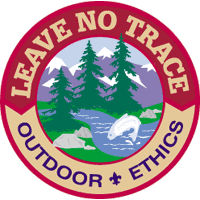
Leave What You Find
Alien Invaders
Invasive species can spread many different interesting ways.
Goal
Participants will understand different ways to accidentally help invasive species spread.
Time
10 minutes
Objectives
Participants will be able to:
- prevent personal distribution of foreign plants
- identify ways invasive species spread
Materials
- pieces of common fabric from old clothes - flannel, nylon pants, fleece, raincoat
- gallon ziploc baggie of cockleburrs
- ziploc of grass seeds
- ziploc of any other plant seeds that stick to clothing
Motivator
- Crossing a high pass from one valley to the next can offer a view of a much different landscape.
- If the same plants take over every location, it all looks the same.
Presentation
- Have participants team up into 2s or 3s.
- Give each small team a different piece of cloth.
- Pass the baggie of burrs around and have each team dip their cloth in, shake it, and pull it out. What happens?
- Which fabrics collected the most burrs?
- Try the same thing with the bag of grass seed or other seeds.
Reflection
- What does this tell us about our choice of fabric for outdoors wear? (nylon and smoother materials collect less material)
- When would we be most likely to gather hitch-hikers such as burrs? (off-trail hiking) So, how can we minimize our impact? (stay on trails)
- If we do get seeds stuck to clothes or in our cuffs or on our pets, when should they be removed? (before traveling any further)
- Wearing clothes without cuffs also helps a bit. How else might we accidentally transport seeds? (in boot treads, in tent, in food)


